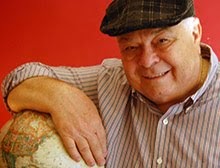 |
| The Luthern Cathedral dominates the skyline of Helsinki (wikipedia) |
Problems with the pronunciation? Don’t worry, just call it the “Rock Church
 |
| Natural light bathes the sanctuary in an array of colors (wikipedia) |
Situated in the heart of Helsinki Finland
 |
| Finnish architect, Eliel Saarinen (wikipedia) |
It is
also a land that has given us such illustrious architects as Alvar Aalto and
the father/son team of Eliel and Eero Saarinen. If the name Saarinen is
unfamiliar, Eero’s contribution to the American landscape is not. It was Eero
who designed the St. Louis Arch which represents the “Gateway to the West” in
the United States
 |
| Shades of purple, natural rock and a copper ceiling are unique features of the Rock Church (wikipedia) |
Temppeliaukio is a story about an architectural competition that began
more than seven decades ago in the 1930s. A plot of land was selected in Helsinki
In 1936 a new contest was announced with the implementation of the
project awarded to Johan Sigfrid Siren. In 1939, the outbreak of World War II
interrupted construction for a second time.
 |
| Aalto Vases (Wikipedia) |
After the war, a 16-year hibernation followed until a third contest was
announced in 1961. This time the honors were awarded to the Suomalainen
brothers, Timo and Tuomo.
Due to financial considerations, plans for the church were reduced to
about one-fourth of the original concept.
Eight years later, in September of 1969, the church opened directly
inside the hollowed out granite that once occupied the square. Throughout the
autumn of 1969 more than 100,000 visitors came to the church and the sanctuary
was frequently full during services.
 |
| Alvar Aalto stamp (wikipedia) |
By 1971, the name was changed from Taivallahti to Temppeliaukio, or its more popular designation as the “Rock Church
Interior
designs bathe the sanctuary in natural light from a skylight in the copper dome
in the center of the building.
 |
| The Gibralter of the North, Suomenlinna Fortress greets visitors who arrive by boat (Wikipedia) |
Among the
unanticipated bonuses from the project are the outstanding acoustics created by
the rock surfaces that comprise the interior walls. While the Suomalainen
brothers did give acoustic considerations for the walls at first, they were not
part of the initial design entry.
 |
| Sibelius monument honors Jean Sibelius (Wikipedia) |
When
Finnish conductor Paavo Berglund gave Mauri Parjo, an acoustical engineer, some
background on utilizing the wall surfaces to take advantage of the exposed
rock, the brothers rethought the idea and opted to the acoustical elements to
their concept.
Today, when
it is not in use as a house of worship, the Rock Church
 |
| The Rock Church organ enhances the surroundings with music (Wikipedia) |
Even with
its mid-20th century design, like so many things in Finland , the Rock Church
Benches are
constructed of native Birch. The floor is polished concrete while the pulpit is
reinforced concrete. The altar is made of evenly sawn granite while water
trickles from cracks in the rock along specially designed ducts.
The copper dome spans a diameter of nearly
80-feet, and the distance from the highest point in the floor to the top of the
dome is 42-feet.
 |
| Aalto's Finlandia Hall (Wikipedia) |
Though Temppeliaukio has no bells, the organ,
designed by Veikko Virtanen, features 43 stops and 3001 pipes.
Despite its beloved status today, the history of
the Rock Church Helsinki
At that time, a major famine was grabbing news
headlines from a place called Biafra which had seceded from eastern Nigeria
 |
| The Esplanade is a favorite spot in the summer (Wikipedia) |
Today the Rock Church Helsinki
 |
| Helsinki is a cultural center and the home of the Rock Church (Wikipedia) |
Temppeliaukio is the product of Finnish ingenuity.
Ingenuity that transformed a massive lump of stone that everyone “took for
granite” into a living “rock of ages.”












































